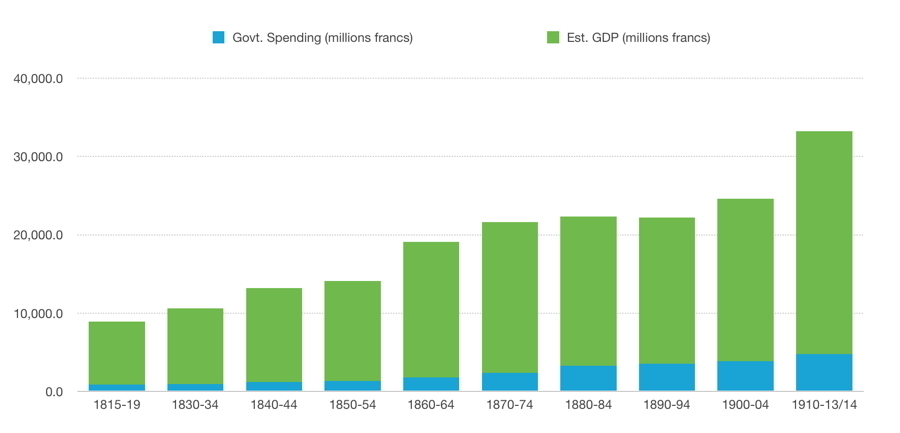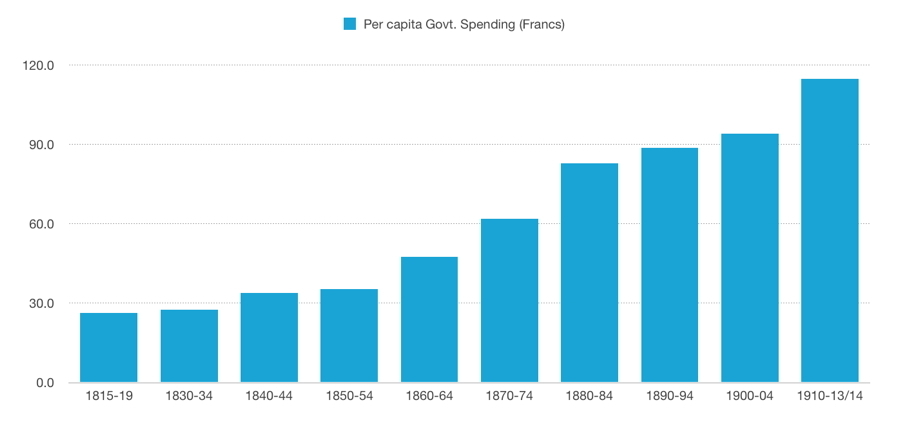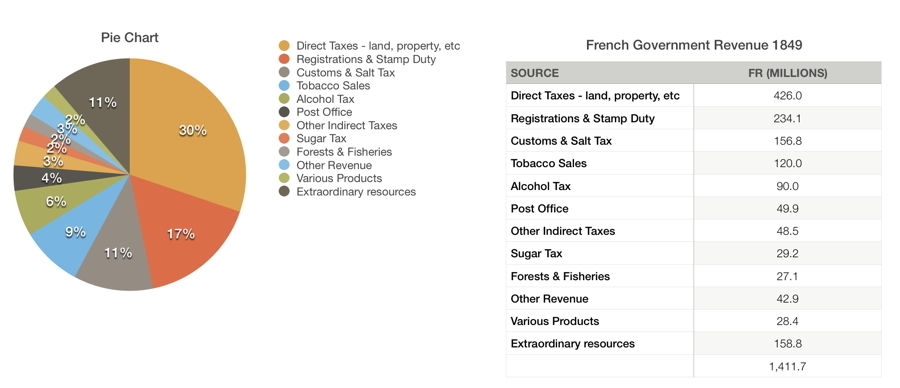French Government Budgets 1848-49
The French Government's Budgets for Fiscal Years 1848 and 1849
[Revised: 28 June, 2017]
Table of Contents
- Introduction
- Overview of the Growth of the French State in the 19th Century
- Bibliography
- Pie Charts summarizing the Data
-
Budget Data Tables
- Table 1. Summary of Expenditure and Income.
- Table 2. Summary of Expenditure.
- Table 3. Details of Expenditure.
- Table 4. Summary of Revenue.
- Table 5. Details of Revenue.
- Table 6. Details of Expenditure for Section III: Ministerial Services.
- Table 7. Expenditure by the Ministry of the Interior in 1848.
- Table 8. Details of Expenditure for Section IV: Costs of Administering and Collecting Taxes and Duties.
Introduction
These tables of data showing the French Government's revenue and expediture for 1848 and 1849 were constructed from several published sources. The bulk of the information comes from Alphonse Courtois' edition of "Le budget de 1849" which was published in the Annuaire de l'économie politique et de la statistique pour 1850 (Guillaumin, 1850). The 1849 Budget report lacks some details which are available in the 1848 Budget report so we have added these were necessary. Additional material comes from Charles Coquelin's article on the "Budget" in the DEP (1852) and the Dictionnaire des Finances, ed. Léon Say (1894). It was done to check the accuracy of Bastiat as an economic journalist when he was writing what became the collections of Economic Sophisms (1846, 1848) which appear in CW3 (2017). We found him to be very accurate and detailed in his use of economic data, even in the more popular press.
There are some discrepencies and differences in the way data was presented by the government during this period, but this is to be expected given the fact that the régime of King Louis Philippe was overthrown in February 1848 which resulted in some economic chaos as the Second Republic was being established during 1848 and while Louis Napoléon began exerting control as President after the election in December 1848. Most notably, revenue collection collapsed as a result of the economic downturn which followed the Revolution and the new demands on expendiute placed on the new government by socialist and other groups which had been ignored and excluded by the old régime. Because of his economic expertise Bastiat was voted by the Constituent Assembly (of which he was a member representing his homeland of Les Landes) to be the vice-president of the Finance Committee which reported to the Chamber on tax and spending matters.
The Budget Reconstruction first appeared as Appendix 4 in CW3, pp. 509-16. For more information about French taxation and other economic policies see Appendix 2: The French State and Politics, CW3, pp. 486-96; and Appendix 3: Economic Policy and Taxation, CW3, pp. 497-508.
Overview of the Growth of the French State in the 19th Century
To get the French Government Budget figures for 1848-49 in perspective we have to have some idea of how large the total French economy was at the time and what proportion of that went through the hands of the French state (central, departmental, and communal). Exact figures are hard to come by and most historians use the data collected by J.C. Toutain in his 1987 monograph "Le Produit Intérieur Brut de la France de 1789 à 1982" (revised slightly in 1990). We have supplemented that with additional data provided by Bonney in "The Apogee and Fall of the French Rentier Regime, 1801-1914" (2010).
These modern figures are comparable to the figures provided by the economists working in the 1840s from official government budget papers which we list below. I believe the discrepancies come from the fact that the economists were using budget figures for the central government and did not take into account local government and city tax collection such as the octroi tolls. What the modern figures provide which these older ones do not is some rough idea of how large the French economy was (GDP) and what the share of total output was provided by agriculture, industry, and other sectors (such as services).
In summary, total government expenditure at this time was about 1,287 million francs which constituted about 9.46% of French GDP (which was about 13,605 million francs). Of this total output, about 39% came from agriculture, 38% from industry, and 24% from other activities such as services. According to OECD figures for 2015 general government spending as a percentage of GDP for France was 56.6% and for the U.S. government 37.7%.
Over the course of the 19th century the share of the total economy of government expenditure ranged from a high of about 12% of GDP after the fall of Napoleon's Empire in 1815 and settled at between 9-10% for the next 50 years until it doubled after 1870 (to about 18%) as a result of the Paris Commune and the Franco-Prussian War. In the thirty year period between 1880 and 1914 government expenditure remained fairly steady at the higher rate of about 16-14% (it was falling slightly). Taking the 1850 level as a benchmark (1,200 m. or 9.4%) government expenditure had tripled to about 3,600 m. francs by 1894, and quadrupled to 4,800 m. by 1913/14 on the eve of the outbreak of the First World War. During the same period the population of France had increased from 36 m. in 1846 to 41.6 m. in 1914, or an increase of 15.5%. However, between 1850 and 1913/14 government spending had increased by 370%. Nevertheless, the overall burden of government spending on the French economy was reducing after 1900 as a spurt in economic growth (as measured by GDP) on the eve of WW1 was increasing much faster than both population growth and the growth in government expenditure. In terms of per capita government spending it was increased substantially from 35.3 francs per person in 1850-51 to 114.9 francs per person in 1910-11.




Bibliography
Alphonse Courtois, "Le budget de 1849" in Annuaire de l'économie politique et de la statistique pour 1850 par MM. Joseph Garnier. 7e année (Paris: Guillaumin, 1850), pp. 18-28.
Alphonse Courtois' edition of "Le budget de 1848" which was published in the Annuaire de l'économie politique et de la statistique pour 1848. 5e Année (Guillaumin, 1848), pp. 29-51.
A. Bernard, "Résumé des Budgets de la France de 1814 à 1847" in the Annuaire de l'économie politique et de la statistique pour 1849. 6e Année (Guillaumin, 1848), pp. 67-76.
Dictionnaire des Finances, publié sous la direction de M. Léon Say, par MM. Louis Foyot et A. Lanjalley (Paris: Berger-Levrault, 1889, 1894). 2 vols. Tome I. -A-D. Tome II. -E-Z. See especially the article on "Budget général de l'État", section 13 "Monarchie de Juillet (1830-1848)", vol. 1, pp. 572-77, and section 14 "Seconde République (1848-1852), pp. 577-79.
Charles Coquelin, "Budget," DEP (1852), vol. 1, pp. 224-35. Coquelin provides information for the years 1850 and 1851 for France, and information about the budgets for Britain, USA, Austria, Prussia, and Belgium.
Richard Bonney, "The Apogee and Fall of the French Rentier Regime, 1801-1914," in Paying for the Liberal State: The Rise of Public Finance in Nineteenth-Century Europe, ed. José Luís Cardoso and Pedro Lains (Cambridge UP, 2010), pp. 81-102.
J.C. Toutain, Le Produit Intérieur Brut de la France de 1789 à 1982 (Paris: Institut des Sciences Mathématiques de Economiques Appliquées, 1987).
J.C. Toutain, "Le Produit Intérieur Brut de la France de 1789 à 1990," ISMEA, Histoire et Sociétés, histoire économique et quantitative, 1, no. 11, 1997, pp. 5-136 (Presses Universitaire de Grenoble).
Toutain Jean-Claude. "Comparaison entre les différentes évaluations du produit intérieur brut de la France de 1815 à 1938 ou L'histoire économique quantitative a-t-elle un sens?," Revue économique, volume 47, n°4, 1996. pp. 893-919.
"General Government Spending," OECD, 2016. <https://data.oecd.org/gga/general-government-spending.htm>.
Pie Charts summarizing the Data
French Government Revenue for 1849

Budget Data Tables
Table 1. Summary of Expenditure and Income.| 1848 | 1849 | |
| Expenditure | 1,446,210,170 | 1,572,571,069 |
| Income | 1,391,276,510 | 1,411,732,007 |
| Deficit | 54,933,660 | 160,839,062 |
Data were taken from the following articles and corrected where necessary:
"Budget de 1848," Annuaire de l'Économie politique et de la statistique pour 1848, pp. 29–51.
"Budget de 1849," Annuaire de l'Économie politique et de la statistique pour 1850, pp. 18–28.
[Henceforth
Annuaire de l'Économie politique et de la statistique = AEPS.]
| 1848 | 1849 | |
| I. Public Debt | 384,346,191 | 455,143,796 |
| II. Grants to Government Bodies | 14,922,150 | 9,608,288 |
| III. Ministerial Services* | 731,335,104 | 882,057,325 |
| IV. Administrative Costs** | 156,892,495 | 155,265,320 |
| V. Reimbursements, Subsidies | 74,185,730 | 70,496,340 |
| VI. Extraordinary Items | 84,528,500 | |
| Total | 1,446,210,170 | 1,572,571,069 |
"Budget de 1848" in AEPS pour 1848, p. 41.
"Budget de 1849" in AEPS pour 1850, p. 18.
* See table 3.III and table 6.
** See table 8 for details.
| 1848 | 1849 | |
| I. Public Debt | 384,346,191 | 455,143,796 |
| - Consolidated debt | 291,287,951 | 300,789,006 |
| - Other | 63,795,490 | |
| - Loans for canals and other works | 9,110,300 | |
| - Floating debt interest | 23,000,000 | |
| - Other interest payments | 29,000,000 | 8,960,300 |
| - For pensions | 54,947,940 | 58,599,000 |
| II. Grants to Nat. Assembly, Executive Office | 14,922,150 | 9,608,288 |
| - Civil List | 13,300,000 | |
| - Chamber of Peers | 790,000 | |
| - Chamber of Deputies | 832,150 | |
| - National Assembly | 8,362,688 | |
| - Executive | 1,245,600 | |
| III. Ministerial Services* | 731,335,104 | 882,057,325 |
| - Justice | 26,739,095 | 26,460,230 |
| - Religion | 39,564,833 | 41,066,393 |
| - Foreign Affairs | 8,885,422 | 7,241,367 |
| - Public Education | 18,038,033 | 21,751,820 |
| - Interior | 116,564,738 | 128,951,534 |
| - Agriculture and Commerce | 14,384,500 | 17,385,823 |
| - Public Works | 110,922,050 | 157,746,633 |
| - War | 322,010,382 | 346,319,558 |
| - Navy and Colonies | 138,540,895 | 119,206,857 |
| - Finance | 17,753,136 | 15,927,110 |
| - (Less supplemental expenditure from previous years) | 82,067,980 | |
| IV. Administrative Costs* | 136,892,495 | 155,265,320 |
| V. Reimbursements, Subsidies | 74,185,730 | 70,496,340 |
| VI. Extraordinary Items | 84,528,500 | |
| Total | 1,426,210,170 | 1,572,571,069 |
"Budget de 1848" in AEPS pour 1848, p. 29–41.
"Budget de 1849" in AEPS pour 1850, pp. 18–23.
* See table 6 for more details.
Table 4. Summary of Revenue.
| 1848 | 1849 | |
| I. Direct Taxes* | 420,669,956 | 426,040,014 |
| II. Registrations, Stamp Duty, Public Property* | 263,359,490 | 234,098,296 |
| III. Forests and Fisheries* | 38,395,700 | 27,072,100 |
| IV. Customs, Salt Monopoly* | 202,112,000 | 156,823,000 |
| V. Indirect Taxes* | 307,962,000 | 287,696,000 |
| VI. Post Office* | 51,738,000 | 49,876,000 |
| VII. Diverse Revenue | 47,053,466 | 42,869,234 |
| VIII. Diverse Products | 19,463,398 | 28,423,000 |
| IX. Extraordinary Resources | 20,298,500 | 158,834,363 |
| (adjustment for discrepancy in totals) | 20,224,000 | |
| Total | 1,391,276,510 |
1,411,732,007 |
The figures for 1848 were calculated by the editor.
"Budget de 1849" in AEPS pour 1850, p. 18.
* See table 5.
Table 5. Details of Revenue.
| Source of Income | 1848 | 1849 |
| General Total Revenue (including debt reserve) | 1,371,052,010 | 1,411,732,007 |
| Total Income from Taxes and Charges (my calculation differs from that in the Annuaire by 20,224,000) | 1,350,754,010 | |
| I. Direct Taxes | 420,669,956 | 426,040,014 |
| - Land Tax | 279,456,080 | 281,274,204 |
| - Personal & Property Tax | 59,313,060 | 60,113,740 |
| - Door & Window Tax | 34,796,826 | 35,655,470 |
| - Trading Licenses | 46,310,100 | 48,190,340 |
| - Other Items | 793,890 | 806,260 |
| II. Registrations, Stamp Duty, Public Property | 263,359,490 | 234,098,296 |
| - Registrations, fees, levies | 216,324,000 | 179,424,000 |
| - Stamp duty | 40,556,000 | 29,206,000 |
| - Sale of land | 3,282,300 | 3,091,316 |
| - Sale of other property | 2,123,500 | 2,236,500 |
| - Other | 1,073,690 | 911,480 |
| - Additional stamp duty | 19,229,000 | |
| III. Forests and Fishery | 38,395,700 | 27,072,100 |
| - Sale of wood | 33,548,500 | 16,770,100 |
| - Fishing rights | 3,069,200 | 3,092,400 |
| - Fees for forest administration | 1,778,000 | 1,000,000 |
| - Other | 1,209,600 | |
| - Additional wood sales | 5,000,000 | |
| IV. Customs, Salt Monopoly | 202,112,000 | 156,823,000 |
| - Import Duty | 105,888,000 | 91,313,000 |
| - Import Duty Colonial Sugar | 38,458,000 | 35,000,000 |
| - Import Duty Foreign Sugar | 11,270,000 | 1,570,000 |
| - Export duties | 1,919,000 | 2,066,000 |
| - Navigation rights | 3,591,000 | 2,847,000 |
| - Other duties | 2,833,000 | 2,874,000 |
| - Imported Salt Tax | 38,153,000 | 21,153,000 |
| V. Indirect Taxes | 307,962,000 | 287,696,000 |
| - Alcohol Tax | 103,603,000 | 90,000,000 |
| - Additional salt duties | 13,346,000 | 4,657,000 |
| - Domestic Sugar Tax | 20,840,000 | 29,168,000 |
| - Other duties | 43,310,000 | 36,500,000 |
| - Tobacco Sales | 120,000,000 | 120,000,000 |
| - Sale of gunpowder | 6,863,000 | 7,371,000 |
| VI. Post Office | 51,738,000 | 49,876,000 |
| - Letter Tax | 46,542,000 | 44,829,000 |
| - Money orders | 673,000 | 1,000,000 |
| - Fees for transporting gold and silver | 214,000 | 210,000 |
| - Mail coach fees | 2,059,000 | 1,700,000 |
| - Packet boat fees | 1,096,000 | 1,102,000 |
| - Foreign transit fees | 1,108,000 | 1,000,000 |
| - Other fees | 46,000 | 35,000 |
| VII. Diverse Revenue | 47,053,466 | 42,869,234 |
| VIII. Various Products from the Budget | 19,463,398 | 28,423,000 |
| IX. Extraordinary Resources | 20,298,000 | 158,834,363 |
| - Supplement | 20,298,000 | 20,000,000 |
| - Debt reserve | 138,834,363 |
"Budget de 1848" in AEPS pour 1848, pp. 48–50.
"Budget de 1849" in AEPS pour 1850, p. 23–25.
Table 6. Details of Expenditure for Section III: Ministerial Services.
| Ministry | 1848 | 1849 |
| I. Justice | 26,739,095 | 26,460,230 |
| II. Foreign Affairs | 8,885,422 | 7,241,367 |
| III. Public Education and Religion | ||
| - Public Education | 18,038,033 | 21,751,820 |
| -- University | 17,910,452 | |
| -- Sciences and Letters | 3,343,676 | |
| -- Admin, etc. | 497,692 | |
| - Religion | 39,564,833 | 41,066,393 |
| -- Catholic | 38,917,983 | |
| -- Non-Catholic | 1,389,584 | |
| -- Admin | 229,295 | |
| -- In Algeria | 529,531 | |
| IV. Interior | 116,564,738 | 128,951,534 |
| - a. [this section is not itemized in 1849 Budget but is in the 1848 Budget. See Table below for details.] | ||
| V. Agriculture and Commerce | 14,384,500 | 17,385,823 |
| VI. Public Works | 110,922,050 | 157,746,633 |
| - Roads and Bridges | 37,265,000 | |
| - Navigation | 31,100,750 | |
| - Railways | 74,788,750 | |
| - Admin | 8,936,540 | |
| - Mines | 40,000 | |
| - Civil Buildings | 5,130,593 | |
| - Other | 485,000 | |
| VII. War | 322,010,382 | 346,319,558 |
| VII. Navy and Colonies | 138,540,895 | 119,206,857 |
| - Navy | 98,893,647 | |
| - Colonies | 20,313,210 | |
| IX. Finance | 17,765,136 | 15,927,110 |
| (less roll-over funds from previous year) | –82,079,980 | |
| Total | 731,335,104 | 882,057,325 |
"Budget de 1848" in AEPS pour 1848, pp. 30–39.
"Budget de 1849" in AEPS pour 1850, pp. 19–21.
Table 7. Expenditure by the Ministry of the Interior in 1848.
| Ministry of the Interior | 1848 |
| Central Administration | 1,328,000 |
| Diverse Services (telegraph, National Guard) | 2,278,500 |
| Fine Arts | 2,614,900 |
| Welfare & Subsidies | 3,440,500 |
| Administration of the Departments | 8,527,200 |
| Prisons | 7,200,000 |
| Royal Court | 565,548 |
| Ordinary Departmental Expenditure | 32,843,040 |
| Optional Departmental Expenditure | 13,131,710 |
| Extraordinary & Special Departmental Expenditure | 43,633,300 |
| Other | 1,002,040 |
| Total | 116,564,738 |
"Budget de 1848" in AEPS pour 1848, pp. 32–34.
| Item | 1848 | 1849 |
| I. Direct Taxes | 17,323,210 | 17,018,362 |
| II. Registrations, Stamp Duty, Public Property | 11,344,700 | 11,359,100 |
| III. Forests | 5,433,500 | 6,673,900 |
| IV. Customs | 26,353,650 | 25,790,720 |
| V. Indirect Taxes, Gunpowder, Tobacco | 61,937,258 | 60,331,130 |
| VI. Post Office | 34,500,177 | 34,092,108 |
| Total | 156,892,495 | 155,265,320 |
"Budget de 1848" in AEPS pour 1848, pp. 39–40.
"Budget de 1849" in AEPS pour 1850, pp. 22–23.